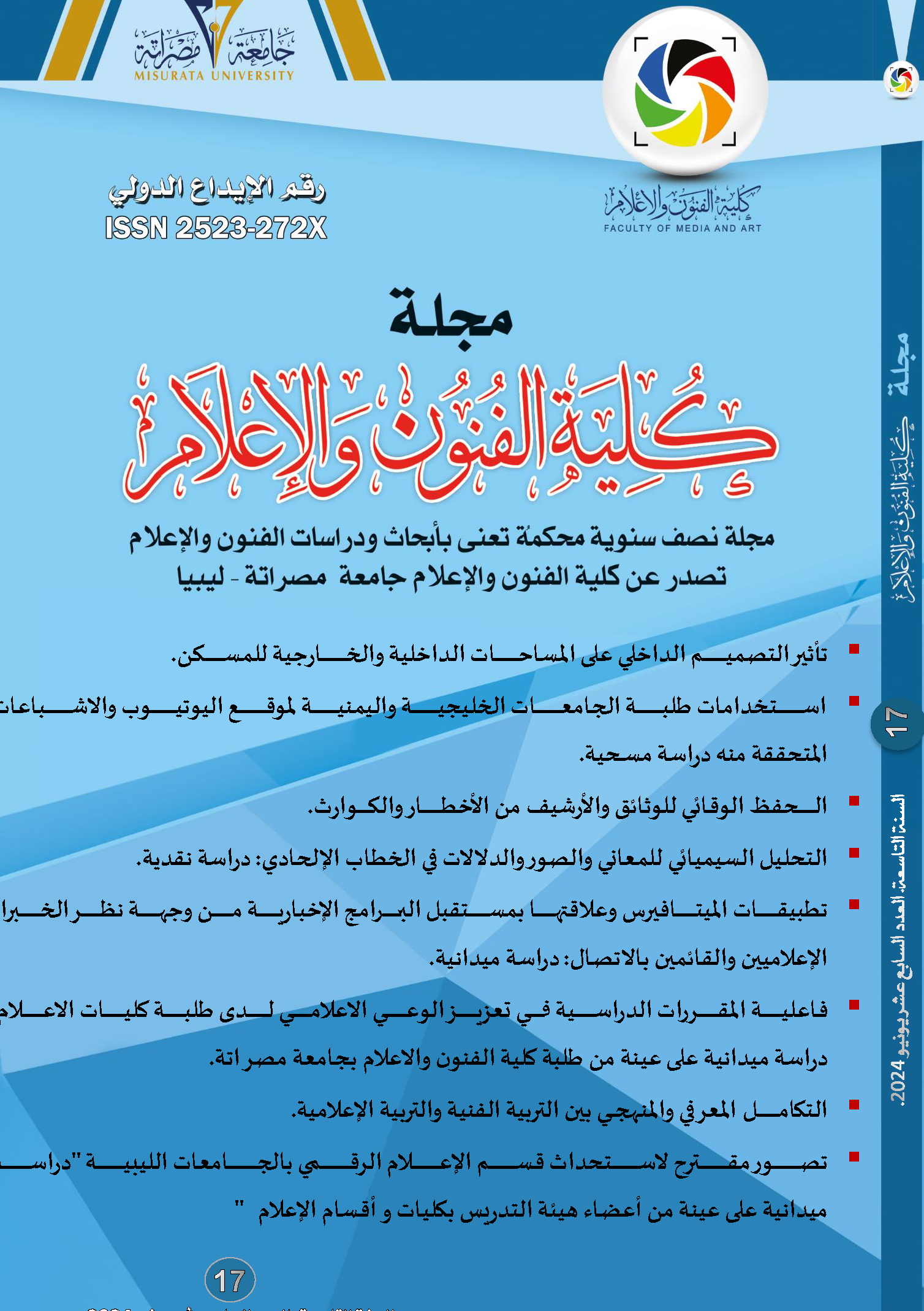The reality of employing artificial intelligence applications in producing media content in Yemeni media institutions - a field study on a sample of producers and preparers
DOI:
https://doi.org/10.36602/famj.2024.17.9Keywords:
applications, artificial intelligence, visual, readable, audible, interlacedAbstract
The aim of the research is to reveal the reality of employing artificial intelligence applications in media production in Yemeni media institutions, identify the most prominent obstacles facing Yemeni media institutions in benefiting from artificial intelligence applications in media production, and find out if there are statistically significant differences attributed to variables: gender, type of institution, experience, age. The descriptive approach was used, and the questionnaire was also used, which was distributed to an intentional sample of producers and preparers in media institutions (channels, radios, newspapers) number (123), and the research revealed a low reality and poor utilization of artificial intelligence applications in Yemeni media institutions, whether in the production of visual content, readable content, Audible content or overlapping content. The results also showed that there are a number of obstacles faced by Yemeni media organizations in their quest to benefit from artificial intelligence applications, most notably: The lack of awareness of the importance of artificial intelligence, the scarcity of training and qualification for workers in media organizations, and the fear of this new technology either because it will replace humans, or because it falsifies facts, or because it violates privacy, the results also showed that there are differences due to the gender variable on the axis of readable content in favor of males, and there are differences due to the type of institution variable in the axis of Audible content in favor of broadcasters, while there are no differences due to the experience variable, as for the age variable, the results showed there are differences in favor of the age group less than 30 years.
References
إسماعيل، فتحي (2022) اتجاهات الصحفيين نحو استخدام الذكاء الاصطناعي في تطوير المحتوى الصحفي بالصحف والمواقع المصرية: دراسة ميدانية لمواقع المصري اليوم، مصراوي، القاهرة.
أطيبقة، عبد الله وعامر، محمد والسني، أحمد (2023). مستقبل توظيف آليات وتقنيات الذكاء الاصطناعي في تطوير عمل المؤسسات الإعلامية العربية – دراسة ميدانية لعينة من القائمين بالإتصال والنخب الأكاديمية في ليبيا وفلسطين، مجلة جامعة الأقصى – سلسلة العلوم الإنسانية، مج27، ع3، ص ص 200-225.
الأنصاري، عمرو (2022) كيف نستعين بالذكاء الاصطناعي لخدمة عمل الصحفي وصناعة المحتوى، شبكة الصحفيين الدولية، https;//bit.ly/3wn76Qw.
البحيري، شيرين (2022). اتجاهات الصحفيين المصريين نحو استخدام تطبيق صحافة الذكاء الاصطناعي (Robot Journalism) في انتاج المحتوى الصحفي بالصحف المصرية، المجلة العلمية لبحوث الصحافة، ع24، جزء1.
بوخاري، مليكة (2023) استخدام الذكاء الاصطناعي في وسائل الاعلام، رؤية نقدية لحدود الاستخدام وآفاق الصحافة، مجلة الدراسات الاعلامية والاتصالية، مج3، ع2، ص ص 71-75.
الحربي، عائض (2023). توظيف تقنية الذكاء الاصطناعي في بنية الإنتاج التلفزيوني- دراسة على عينة من العاملين بالقنوات الفضائية العربية، مجلة علوم الاتصال، جامعة أم درمان مج8، ع1.
الزهراني، أحمد (2022) تبني الصحفيين العرب لتطبيقات الذكاء الاصطناعي في المؤسسات الإعلامية، المجلة الجزائرية لبحوث الاعلام والرأي العام، مج5، ع1، ص ص 15-39.
سلامة، حسام. (2023). توظيف تقنيات الذكاء الاصطناعي في تطوير إنتاجية طلبة الإعلام في الجامعات الخليجية، مجلة اتحاد الجامعات العربية لبحوث الإعلام وتكنولوجيا الاتصال، ع1، جزء1.
صلاح الدين، عواد (2023). توظيف تقنيات الذكاء الاصطناعي في النشاط الإعلامي، مجلة الدراسات الإعلامية والاتصالية، مج3، ع2، ص ص 95-107.
عبد الحميد، عمرو. (2020). توظيف تطبيقات الذكاء الاصطناعي في انتاج المحتوى الإعلامي وعلاقتها بمصداقيته لدى الجمهور المصري، مجلة البحوث الإعلامية، جامعة الأزهر، ع55، جزء5.
فياضي، حسام الدين (2023). الذكاء الاصطناعي ومستقبل البشرية، مجلة المجتمع العلمي العربي.
المنيف، أمجد (2021) الصحافة في عصر البيانات والذكاء الاصطناعي، مركز سمت للدراسات.
ثانيا: المراجع باللغة الإنجليزية:
Andrey, M. (2020). AI to Bypass Creativity will Robots Replace Journalists? Journal Information (Switzerland). Vol. 9. Issue.7.
Jose, M. (2020). Impact of Artificial Intelligence on Journalism; Transformations in the Company, products, contents and professional profile, communication & society, vol,34. Issue,3. Pp 177-193.
Moravec, Vaclav, Mackova, Veronika; Sido Jakuv; Eksten, Kamil. (2020). Communication Today; Tmava, vol, 11, Issue, 1, pp 36-53.











